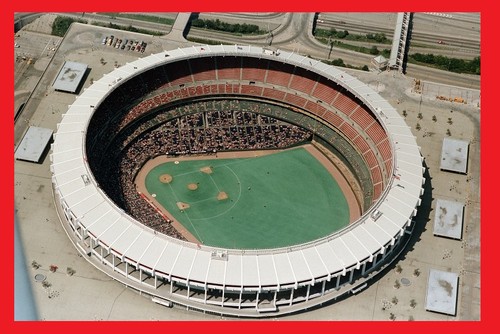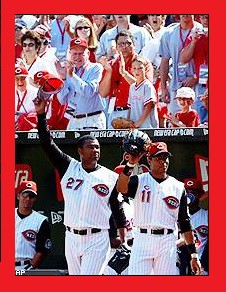
The Last Hurrah is a series that discusses the final major sports events at sporting venues around the world.
On Sunday, September 22nd, 2002, the Philadelphia Phillies faced the Cincinnati Reds for the final MLB game to be held at Cinergy Field (more commonly known as Riverfront Stadium) in Cincinnati, Ohio.
Riverfront Stadium opened in 1970 after over two years of construction, hosting both the Reds and the NFL’s Cincinnati Bengals. For the Reds, the stadium replaced their previous home of Crosley Field, which the team had been playing at for nearly 58 seasons, while for the Bengals it replaced their home of just two seasons in Nippert Stadium, which still exists today as the home of the NCAA’s Cincinnati Bearcats football team as well as FC Cincinnati of Major League Soccer.
Over the course of the next 32 years, Riverfront Stadium earned a special place in history. It was the Reds’ field for World Series championship seasons in 1975, 1976 and 1990, however it also became an important spot for the Oakland Athletics as they claimed the 1972 World Series at Riverfront Stadium after beating the Reds four games to three, to date the most recent major sports championship to be won in Cincinnati. The stadium also became notable for hosting what is still to this day the coldest game in NFL history, as the San Diego (now Los Angeles) Chargers faced the Bengals in the 1982 AFC Championship, which was a reported -9 degrees Fahrenheit and -37 degrees with wind chill, as the Bengals went on to win 27-7 to move on to the Super Bowl. The stadium also saw milestones in being the location of Hank Aaron’s record-tying home run in 1974 as well as Pete Rose’s record-breaking hit in 1985.
Despite a name change in September 1996 from Riverfront Stadium to Cinergy Field after the now-defunct energy company for $6.5 million, the stadium still looked outdated by comparison to the rush of new stadiums opening in the late 1990s and early 2000s, with nearly all still in use today. In 2000, the Bengals moved into their new home known as Paul Brown Stadium, leaving the Reds as the lone remaining tenant. Also in 2000, Cinergy Field was resurfaced from its long-standing Astroturf field to natural grass, allowing the infield dirt to go all the way around the baseline instead of the characteristic dirt patches immediately around the bases themselves. However, prior to the 2002 season it was announced that the upcoming season would be the last at Riverfront Stadium for the Reds.
Going into the final game, both teams were going through mediocre seasons, as the Phillies held a record of 77-78 while the Reds were 75-80. However, the Phillies were coming into the game with all the momentum after beating the Reds in the first two games of the series in extra innings in a doubleheader on Saturday after Friday’s game was rained out. With a 5-3 win in 10 innings in the first game on Saturday afternoon and a 5-4 victory in 11 innings in the second game on Saturday night, the Phillies looked to complete the sweep on Sunday.
The Phillies sent young pitcher Brandon Duckworth to the mound, as he was looking to build on a 6-9 record as time was running out in the Phillies’ season. Meanwhile, the Reds started veteran Jose Rijo, who had played a major role in the Reds’ World Series championship in 1990, but had battled with injuries throughout the bulk of his career, including being forced to take a six-year break from playing after a number of setbacks with his elbow and shoulder. However, Rijo held a respectable 5-3 record coming into the game.
The pregame festivities saw appearances from Reds greats such as Tom Browning, Sparky Anderson and Johnny Bench. Rose had reportedly also wanted to be a part of the ceremonies, but was denied by the MLB on the grounds that his permanent suspension from the MLB also extended to ceremonial purposes. In response, the team placed a rose in the middle of the Reds logo behind home plate prior to the game.
The game got started at about 1:15 in the afternoon, as the Reds got off to good start with center fielder Ken Griffey Jr. hitting a sacrifice fly along with help from a fielding error from Phillies shortstop Jimmy Rollins to score second baseman Todd Walker in the bottom of the first inning as Griffey hit the ball to deep center field, moving Walker from second to third, followed by the throw back into the infield squirting away from Rollins to allow Walker to score. However, the lead would be short lived as Duckworth created his own run support in the top of the second, hitting an RBI single to right to score second baseman Marlon Anderson from second, tying the game at 1-1.
The third saw the Phillies take the lead as Rollins recovered from his error in the first to score from second on an RBI single to right by right fielder Bobby Abreu, however the Reds clawed back in the fourth to tie it at 2-2, with third baseman and current Yankees manager Aaron Boone hitting an RBI single to center, scoring first baseman Adam Dunn from second.
In the fifth, the Phillies took the lead once again with first baseman Travis Lee driving in Abreu from second with an ground rule double, as the ball went over the head of right fielder Jose Guillen before skipping off the dirt and over the right field wall. That would be the end of the day for Rijo, who was taken out along with Larkin as part of a double switch. Rijo tipped his hat to the fans as he exited, going out to a round of applause in what would be his final home game as a Red. Rijo and Larkin, the two Reds players still in the lineup from the 1990 championship season, then both tipped their caps in recognition to the crowd of almost 41,000, as seen below:

Rijo was replaced by reliever Brian Moehler, while Larkin was relieved by Travis Dawkins at shortstop. Despite giving up a walk, Moehler got the final out of the inning with no further runs allowed to keep the Reds in contention. After a scoreless bottom of the fifth the Reds brought Moehler back for another scoreless inning, but would be unable to capitalize in the bottom of the sixth despite a single and stolen base from Boone and a walk drawn by pinch hitter Russell Branyan. In the seventh, the Reds brought in reliever Bruce Chen, who promptly pitched a one-two-three inning, but Duckworth would continue to hold them off with a scoreless bottom of the seventh.
Chen came back in the eighth inning, but would not get out cleanly this time as Anderson hit an RBI sacrifice fly to center, scoring Lee from third base, but third baseman Placido Polanco also tried to advance from second, but was thrown out at third by Dunn, who cut off the original throw from Griffey, for a double play. Nevertheless, the run by Lee still scored as the Phillies took a 4-2 lead.
In the bottom of the eighth, Duckworth was replaced by Dan Plesac at pitcher while Tomas Perez, who had pinch hit for left fielder Ricky Ledee, stayed in the game at second base, while the new left fielder Jason Michaels entered the game and Anderson exited with a run and an RBI to his credit. It didn’t take long for the Reds to jump on Plesac as Boone knocked a solo home run to left center field, cutting the Phillies’ lead in half. Plesac was taken out immediately after the home run in favor of closer Jose Mesa, while the Reds also opted for a pitching change as rookie outfielder Wily Mo Pena pinch hit for Chen, but would be unable to keep the inning going.
The new pitcher for the Reds and the final Reds pitcher to take the mound at Riverfront Stadium/Cinergy Field was Chris Reitsma, who began the season as a starter but was moved to the bullpen towards the end of the year. Reitsma worked around a hard-hit single and a wild pitch to keep the deficit to within a manageable distance. Mesa returned in the bottom of the ninth and while he got the first batter out in left fielder Reggie Taylor, he walked catcher Kelly Stinnett and was visibly frustrated by the ball four call, prompting Phillies manager Larry Bowa to make a mound visit. Mesa settled back in and got Dawkins to strike out, then got Walker to hit a weak grounder to Perez at second base, who tossed it over to Lee to end the game with a 4-3 Phillies win as well as a series sweep. Mesa also broke the Phillies’ single-season record for saves, as his record still stands to this day.

After the game, the Reds continued to pay tribute to the stadium’s legacy, taking home plate so it could be moved to their new stadium in Great American Ball Park. Browning also spray painted ‘14’ on the mound following the game in further acknowledgement of Rose and his accomplishments at the stadium.
The Phillies went on to split a two game series against the Braves before taking one out of three against the Marlins to finish out the season with an 80-81 record. The Reds, meanwhile, traveled to Chicago and swept the Cubs in a three game series, before being swept by the Montreal Expos (now Washington Nationals) in another three game road set to close out the regular season with a 78-84 record.
With Great American Ball Park built right next door to the stadium and with no remaining tenants, the structure was demolished on Sunday, December 29th, 2002, in a controlled implosion using around 1,400 pounds of explosives. The site that the stadium was on is now used for the National Underground Railroad Freedom Center along with the Reds Hall of Fame and Museum, both of which opened in 2004.
Follow me on Twitter: twitter.com/Zmiller_82
Support me on Patreon: patreon.com/Zmiller82
Link to stats database: https://www.baseball-reference.com/boxes/CIN/CIN200209220.shtml
Watch the full game: https://www.youtube.com/watch?v=JH6HpB7bsH4
Stadium demolition footage: https://www.youtube.com/watch?v=FtD36tlAQGg
Other sources:
http://www.espn.com.au/mlb/recap?gameId=220922117
https://www.bizjournals.com/cincinnati/stories/1997/04/28/newscolumn4.html
https://sabr.org/bioproj/person/ef1d7b7e
https://www.cincinnati.com/story/sports/2015-All-Star-Game/2017/12/29/15-years-ago-today-cinergy-field-implosion/990038001/
Up next: Tampa Bay Buccaneers v. St. Louis Rams 12/17/15 @ Edward Jones Dome, coming December 28th (Or read now on Patreon: https://www.patreon.com/posts/last-hurrah-5-v-23486519)
Comments